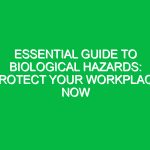Introduction
Good morning, team! Today, we’re gathered for our toolbox talk to discuss a critical health topic that affects all of us—Heart Attacks. Understanding the signs, risk factors, and preventive measures related to heart health is essential, especially in our work Environment where physical stressors can increase risks. By being aware and prepared, we can help safeguard not only our health but also that of our coworkers.
What is a Heart Attack?
A Heart Attack, also known as a myocardial infarction, occurs when blood flow to a part of the heart is blocked for a long enough time that part of the heart muscle is damaged or dies. This blockage is often caused by a buildup of fat, cholesterol, and other substances in the coronary arteries, forming a plaque. When this plaque ruptures, a blood clot can form, leading to the blockage of blood flow.
Recognizing the Signs of a Heart Attack
Being able to recognize the signs of a Heart Attack can make a significant difference in outcomes. Typical symptoms include:
- Chest pain or discomfort that may feel like pressure, squeezing, fullness, or pain.
- Pain or discomfort in the arms, back, neck, jaw, or stomach.
- Shortness of breath, which may occur with or without chest discomfort.
- Other signs may include cold sweat, nausea, or lightheadedness.
It’s crucial to note that symptoms can vary between individuals, and women may experience different symptoms than men. Encourage your colleagues to speak up if they feel unwell or exhibit any of these symptoms.
Risk Factors Associated with Heart Attacks
Understanding risk factors is essential for Prevention. Here are some major risk factors associated with Heart Attacks:
- High Blood Pressure: This condition makes the heart work harder, increasing the risk of heart disease.
- High Cholesterol: Elevated levels of LDL cholesterol can lead to plaque buildup in arteries.
- Smoking: Tobacco use significantly increases the risk of heart disease.
- Diabetes: Poorly controlled blood sugar levels can damage blood vessels and nerves that control the heart.
- Obesity: Excess weight can contribute to high blood pressure, high cholesterol, and diabetes.
- Sedentary Lifestyle: Lack of physical activity is a significant risk factor.
- Stress: Chronic stress may damage arteries and worsen other risk factors.
By being aware of these factors, we can take proactive steps to mitigate risks not only for ourselves but also for our coworkers.
The Importance of Heart Health in the Workplace
Our work environment can be a significant contributor to our heart health. Physical labor, long hours, and high-stress situations can lead to increased risk. Here are several ways we can promote heart health together:
- Regular Breaks: Taking short breaks during physically demanding tasks helps reduce stress and fatigue.
- Hydration: Staying hydrated is essential for overall health and can help prevent fatigue and stress.
- Healthy Eating: Make a conscious effort to choose heart-healthy snacks and meals while on the job.
- Physical Activity: Incorporate movement into your day, whether through stretching or short walks during breaks.
By implementing these simple strategies, we can create a healthier work environment that prioritizes heart health.
Creating a Heart-Healthy Culture
As employees, we all play a role in fostering a heart-healthy culture. Here’s how:
- Encourage Open Discussion: Create an environment where discussing health concerns, including heart health, is normalized.
- Lead by Example: Practice heart-healthy habits and encourage your coworkers to do the same.
- Support Each Other: Be attentive to your colleagues’ well-being, especially if they exhibit signs of distress.
Emergency Response to Heart Attacks
In the event of a suspected Heart Attack, quick action is vital. Here’s what to do:
- Call for Help: Immediately dial emergency services if someone shows signs of a heart attack.
- Keep the Person Calm: Encourage them to sit down and try to relax while waiting for help.
- Loosen Tight Clothing: This can help the person breathe more easily.
- If They Are Conscious: Offer them aspirin if they are not allergic, as it can help thin the blood.
- Perform CPR if Necessary: If the person is unconscious and not breathing, begin CPR until emergency responders arrive.
Knowing how to respond can save a life. Make sure everyone is familiar with these steps and feels empowered to act if necessary.
Training and Preparedness
Regular Training on recognizing the signs of a Heart Attack and understanding emergency Procedures is essential. Here are some key points to consider:
- First Aid Training: Ensure that all employees have access to first aid training that includes CPR and AED (Automated External Defibrillator) use.
- Regular Drills: Conduct emergency drills to practice responding to a heart attack scenario.
- Health Screenings: Encourage participation in health screenings to identify and manage risk factors early.
By being prepared, we can respond quickly and effectively in an emergency, potentially saving lives.
Regulations and Company Policies
It’s essential to stay informed about any Regulations and company policies related to health and Safety in the workplace. Compliance with Occupational Safety and Health Administration (OSHA) standards and other local regulations ensures that we maintain a safe work environment. Familiarize yourself with:
- Emergency action plans.
- Health and Safety training requirements.
- Reporting procedures for health-related incidents.
By adhering to these regulations, we not only protect ourselves but also uphold our legal obligations as a company.
Conclusion
In conclusion, today’s toolbox talk has covered the importance of Heart Attacks in the workplace and how we can collectively take steps to promote heart health. Remember the signs and symptoms, recognize the risk factors, and know the emergency procedures. Your health and the health of your colleagues depend on our commitment to being vigilant and prepared.
Thank you for your attention today. Let’s work together to foster a safe and healthy work environment. I’d like to open the floor for any questions or thoughts you might have regarding heart health.


